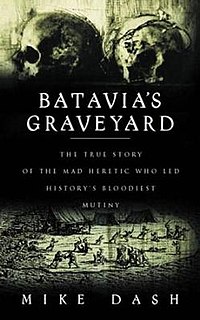 First edition (UK) | |
| Author | Mike Dash |
|---|---|
| Language | English |
| Subject | History of the Netherlands |
| Genre | Non-fiction |
| Publisher | Weidenfeld & Nicolson (UK) Crown Publishers (US) |
Publication date | 2001 |
| Pages | 378 |
| ISBN | 9780609607664 |
| OCLC | 948685376 |
| 919.41/3 | |
Batavia's Graveyard: The True Story of the Mad Heretic Who Led History's Bloodiest Mutiny is a book released in 2001 by Welsh author Mike Dash about the Dutch East India Company ship Batavia, shipwrecked in 1629 on a small atoll of the Houtman Abrolhos, off the western shore of Australia. [1] [2] [3] [4]